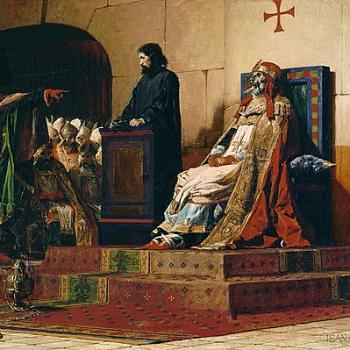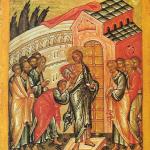As we swiftly move toward November — what Rumer Godden calls a time “full of howling winds and holy souls,” — the Patheos Public Square is taking a multi-channel look at death and religious customs, with Remembering the Dead: Ancestors, Rituals and Relics.
This is of interest to Catholics because, let’s face it, we do death very well, we are often entertained by it (Tom McDonald has been writing about ghosts and floating songs about death all month!), and we are nearing the feasts of All Saints and of All Souls. It’s also interesting to take a look at what other faiths think of death. If your kids are doing a report on death-related issues for school, think of Patheos as their resource.
One glad feature of the death-fest is the return of Max Lindenman, participating from his berth in Turkey and ruminating on all we lose as we increasingly choose cremation over burial:
If we and the details of our lives slip completely into invisibility, with them goes even the small chance that our power to intrigue and inspire will outlast the small circle of our closest acquaintances. Flannery O’Connor published a story titled “You Can’t Be Any Poorer Than Dead.” Well, you can’t be any more atomized than dead and buried where nobody will ever, ever notice you. . . Meditating on gravestones can feel like trying on a variety of lives and deaths. How does a family stay so close that three generations are willing to spend an eternity together beneath a black marble headstone the size of a dumpster? What was it like for the surviving loved ones of this young man, killed in action in Europe on April 28, 1945, to see the Axis break so soon afterward?
It’s great to read him again.
The Catholic channel, not surprisingly, embraced the death theme enthusiastically. Here is Tod Worner, relating the six words that explained Catholic death-thought to his Protestant-to-Catholic sensibility:
As the day would grow late and the stream of visitors would fall to a trickle, Dick’s lovely and long-suffering wife Sharon would, for one last time, climb into bed with her life’s love. To hold him. To feel him. To simply be near and love him as he prepared for his final journey home. Ask any of Dick and Sharon’s children what they saw in Sharon after these irreplaceably tender moments and, to a person, they would say, “She was glowing.”
Elizabeth Duffy has a charmer of a piece about the strength of her grandmother, still felt after her passing:
You see the other side of the story as you age, and the childhood sting hurts less. This is how I believe my grandmother is still working in my life, making her apologies known to me in my own experience. Preventing me from repeating her mistakes. And I offer the discipline for her soul in Heaven. Years after her death, we are still sanctifying one another.
Kyle Cupp writes on the creative ways we remain in touch with and near to those we have lost:
We Catholics believe that life continues after death and that those who love as they ought will find eternal peace. Nevertheless, death hurts so, so much. We fear it. We grieve and we mourn. We struggle to make sense of it all. We have our bad days and really bad days. Sometimes we don’t find any comfort or consolation, even when we turn to God’s heavenly promises. My wife and I lost a newborn a few years ago. When I pray in memory of our daughter Vivian, I’m not filled with comfort and I don’t find myself much consoled. My faith doesn’t diminish the pain, but it helps me make sense of the loss.
All of these pieces contain some heart-wrenching wisdom and, in a very Catholic way, something warm to smile over. Some of it put me in mind of my brother’s death:
[Arranging for his cremation] several friends sensibly advised us not to spend much money on the casket — to buy something cheap or rent something a little nicer, but still not to go overboard. . .It was good advice, I guess, but S — smart as he was — was never sensible about money and when we saw the shiny black-and-chrome number with a rental fee that rivaled some used cars, we threw sensibility out the window. S loved flashy, he loved black and silver and red. We found a casket that looked like it belonged in Vegas, and we knew we had to get it for him. It was so him! “Pile red roses on it,” I had told my husband, “and no matter who comes to the wake, they’ll walk in and say, “that’s him!”.
As, indeed, they did.
I don’t know if I’m stepping in Tom McDonald’s way, here, but let’s end on a tuneful note, and a look at some interesting death masks:
Related:
Sherry Antonetti: The Happiest Mass I Ever Attended Was a Funeral
Max Lindenman: Incorrupt: Mummies, Miracles and Dry, Dry Bones
Kathy Schiffer: Purgatory and Presumption: Please don’t forget to pray for me!
Tom McDonald: In the Midst of Life We Are in Death














